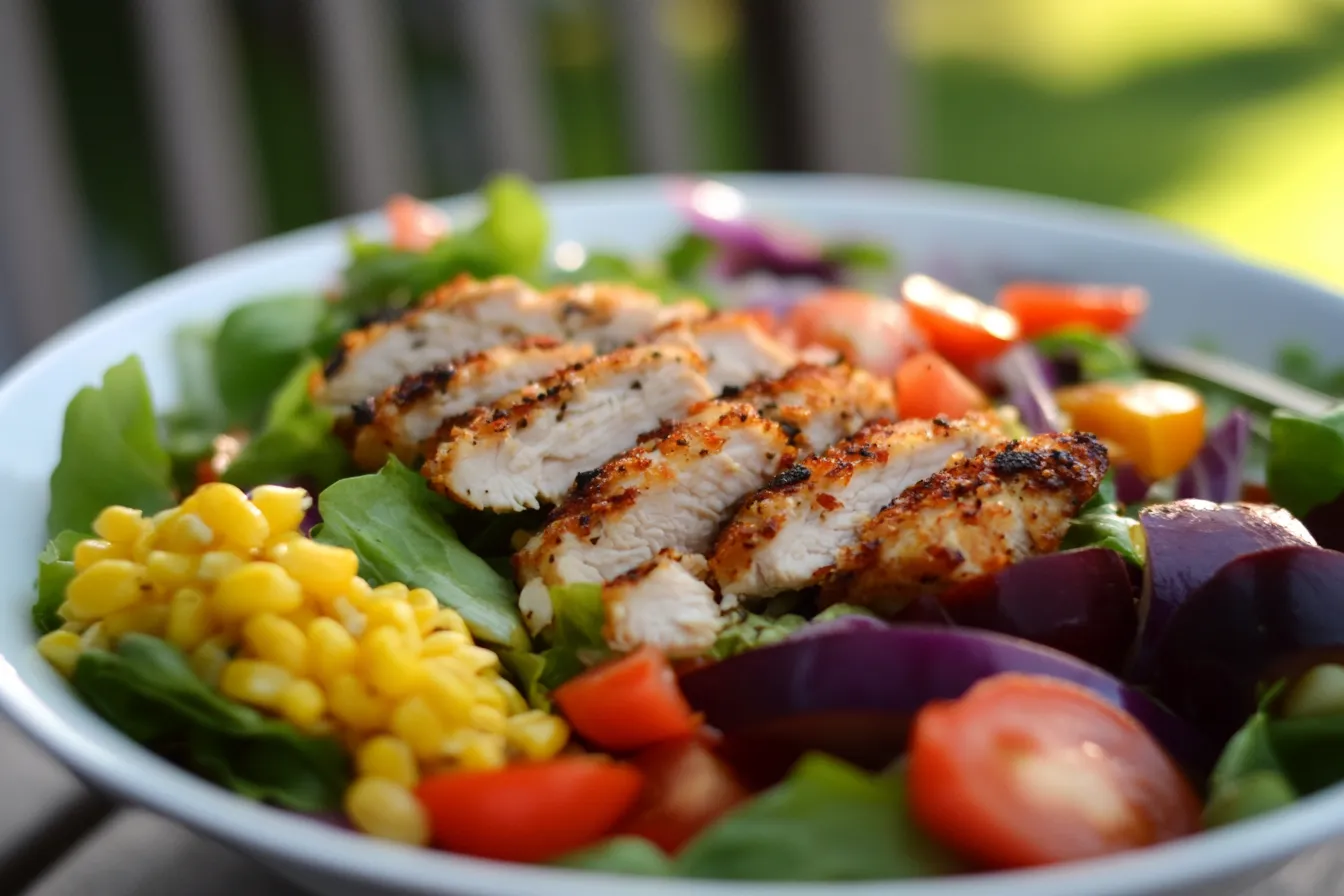Have you ever craved a meal that’s both satisfying and healthy, but felt stuck between a boring salad and something too indulgent? Let’s change that! A crispy chicken salad brings the best of both worlds—a hearty crunch, fresh veggies, and flavors that hit all the right notes. Whether you’re looking for a quick lunch idea, a wholesome dinner, or a dish that feels like a treat without the guilt, this salad has you covered. It’s time to ditch the bland and embrace a salad that’s designed to wow your taste buds and keep you coming back for more. Let’s dive in!
List Of Contents
What is Fried Chicken Salad?
Fried chicken salad combines crispy, golden-fried chicken with fresh vegetables and flavorful dressings. It’s a popular dish in both restaurants and home kitchens because it merges indulgence with a perception of healthiness.
Many people enjoy fried chicken salads as a meal that satisfies both cravings for something hearty and the need for something fresh. The combination of textures – crunchy chicken, crisp greens, and creamy dressings – is undeniably appealing. Check out more recipes here.

Nutritional Overview of Fried Chicken
Fried chicken is loved for its juicy meat and crispy coating, but it comes with nutritional drawbacks:
- Caloric Content: A single piece of fried chicken can have between 300–400 calories depending on its size and preparation.
- Fat and Sodium: Frying often involves oils high in saturated fats, and the breading is usually seasoned with high amounts of salt.
- Nutritional Downsides: The frying process diminishes the nutritional value of chicken, adding empty calories and unhealthy fats.
While fried chicken can be part of a balanced diet in moderation, frequent consumption contributes to higher cholesterol levels and weight gain. Check out more recipes here.
The Role of Salads in a Healthy Diet
Salads are often considered a symbol of healthy eating. When made with nutrient-dense ingredients like leafy greens, colorful vegetables, nuts, and lean proteins, they offer a powerhouse of vitamins, minerals, and fiber. Check out more recipes here.
Benefits of eating salads include:
- Improved digestion due to high fiber content.
- Weight management through lower calorie density (in non-fried options).
- A natural source of antioxidants and essential nutrients.
However, salads can quickly become less healthy when topped with calorie-dense dressings, fried proteins, or sugary add-ons like candied nuts. Check out more recipes here.
Why Combine Fried Chicken with Salad?
Fried chicken salad strikes a balance between indulgence and health. People often add fried chicken to salads to make the meal more satisfying, especially when transitioning to healthier eating habits. The protein from the chicken keeps you full longer, and the salad’s vegetables add freshness and crunch.
This blend appeals to those who want a treat while still consuming a base of healthy greens. However, the nutritional impact of fried chicken and high-fat dressings can tip the scales toward unhealthy. Check out more recipes here.
Common Variations of Fried Chicken Salad
Depending on where you are, fried chicken salads take on different forms. Popular variations include:
- Southern Fried Chicken Salad: Featuring buttermilk-fried chicken, cheddar cheese, bacon, and ranch dressing.
- Asian-Inspired Versions: Tossed with sesame ginger dressing, mandarin oranges, and crispy wontons.
- Tex-Mex Style: Includes ingredients like avocado, black beans, and spicy jalapeño ranch dressing.
Dressings and add-ons greatly influence the overall healthiness of these variations.
Nutritional Breakdown and Health Implications
Caloric and Macronutrient Profile
When breaking down a fried chicken salad, it’s important to evaluate the individual components:
- Fried Chicken: A typical fried chicken breast contains:
- 300–400 calories
- 20–25 grams of fat
- Around 1,000 milligrams of sodium
- Vegetables: A combination of greens, tomatoes, cucumbers, and carrots can contribute:
- Less than 100 calories
- Rich in vitamins A, C, and K
- High fiber content for digestion
- Dressings: One serving (2 tablespoons) of ranch dressing can add:
- 150–200 calories
- 16–18 grams of fat
- 300 milligrams of sodium
Combined Impact: A full portion of fried chicken salad with traditional dressing can exceed 900 calories and contain upwards of 60 grams of fat. While the vegetables are nutrient-dense, their benefits are often overshadowed by the caloric load of the chicken and dressing.
Comparison with Grilled or Baked Chicken Salads:
- A grilled chicken salad typically ranges from 400–600 calories, with less saturated fat and sodium.
- Swapping fried for grilled chicken significantly reduces unhealthy components while retaining protein and flavor.
Impact of Frying on Nutritional Value
Frying not only increases calorie count but also alters the quality of the nutrients:
- Protein Retention: While chicken is a great source of lean protein, the frying process can denature the proteins, making them harder for the body to process.
- Fat Absorption: Chicken absorbs the oil used in frying, which adds saturated and sometimes trans fats, depending on the oil.
- Oxidative Stress: Repeatedly heating oils at high temperatures can produce compounds linked to inflammation and oxidative stress in the body.
Choosing the Right Oils: If frying at home, use oils with a high smoke point like avocado or peanut oil to minimize harmful effects. However, these are seldom used in fast food or store-bought options.
Healthier Alternatives for Fried Chicken Salad
For those who enjoy fried chicken salad but want a healthier option, consider these swaps:
- Air-Fried Chicken: Air fryers use convection heat to replicate the crispiness of fried chicken with a fraction of the fat.
- Baked Chicken: Baked chicken coated in breadcrumbs offers crunch with fewer calories and less oil.
- Lean Protein Additions: Substitute with lean grilled meats, tofu, or legumes for a protein boost without extra fat.
These alternatives can cut calories by 30–50% while still providing a satisfying meal.
Role of Salad Dressings

Dressings are often the stealthiest calorie bomb in salads. The difference between a healthy and indulgent fried chicken salad often comes down to what’s drizzled on top. Here are some common dressing pitfalls and their healthier counterparts:
- Cream-Based Dressings: Ranch, blue cheese, and Caesar are rich but often high in saturated fat and calories.
- Healthier Alternatives: Opt for vinaigrettes or yogurt-based dressings.
- Sugar-Heavy Options: Sweet dressings like honey mustard or poppyseed can pack more sugar than expected.
- Healthier Alternatives: Mix balsamic vinegar with a touch of honey for a homemade, lower-sugar option.
Tips for reducing dressing impact:
- Serve dressing on the side and dip each bite.
- Dilute store-bought dressings with lemon juice or water.
Hidden Ingredients in Store-Bought Versions
Pre-made or restaurant-served fried chicken salads often include ingredients that aren’t immediately obvious:
- Preservatives and Additives:
- To prolong shelf life, manufacturers often include preservatives that may cause bloating or discomfort in sensitive individuals.
- Excess Sodium:
- Sodium from the fried chicken and the dressing can easily exceed recommended daily intake levels, leading to water retention and increased blood pressure.
- Sugars and Artificial Sweeteners:
- Found in unexpected places, like dressings or candied toppings, these contribute to hidden calories.
To avoid these issues, consider preparing fried chicken salad at home, where you control every ingredient.
Making Fried Chicken Salad Healthier
Tips for Healthier Homemade Fried Chicken Salad
Transform your fried chicken salad into a healthier meal by adjusting the preparation process and ingredients:
- Opt for lean chicken cuts like skinless breasts or thighs.
- Experiment with whole-grain breadcrumbs or crushed nuts for breading to add fiber.
- Cook at home with healthier oils or use an air fryer to minimize fat content.
- Choose organic, fresh vegetables to maximize nutritional value.
By controlling ingredients, you can create a fried chicken salad that is both delicious and nourishing.
Adjusting Portion Sizes
Another effective strategy for healthier eating is controlling portion sizes:
- Chicken: Keep the portion to 3–4 ounces per serving, roughly the size of a deck of cards.
- Limit dressings to 2 tablespoons and opt for low-fat or lighter alternatives.
- Vegetables: Double up on greens and low-calorie vegetables to make the meal more filling without adding significant calories.
Balancing these components ensures you enjoy the flavors without overloading on calories or fats.
Including Nutrient-Dense Ingredients
To elevate the nutritional profile of your salad:
- Add superfoods like spinach, kale, or arugula for a vitamin boost.
- Include healthy fats from avocado, nuts, or seeds for sustained energy.
- Increase fiber by incorporating beans, quinoa, or whole grains.
These nutrient-rich additions balance the indulgence of fried chicken while improving the meal’s overall health benefits.
Moderation and Occasional Indulgence
Fried chicken salad might not be suitable for daily meals, but it can be part of a balanced diet when enjoyed in moderation. To indulge mindfully:
- Enjoy the salad with water or unsweetened tea as a healthier alternative to sugary beverages.
- Limit fried foods to occasional treats rather than regular staples.
Mindful eating tips:
- Savor each bite, focusing on flavors and textures.
- Focus on your meal by avoiding distractions like TV or phones to help prevent overeating.
Comparing Homemade vs. Restaurant Versions
Preparing fried chicken salads at home is usually a healthier option compared to ordering them at restaurants. Here’s why:
- Control Over Ingredients: At home, you can choose lean proteins, fresh vegetables, and low-calorie dressings.
- Choose smaller portions: as restaurant salads are often oversized and can contribute to excessive calorie consumption.
- No Hidden Additives: Avoid preservatives, excess sodium, or unhealthy oils by preparing your salad from scratch.
When eating out, opt for grilled chicken instead of fried, and choose vinaigrettes over high-calorie dressings for a lighter option.
Is Fried Chicken Salad Good for You?
Fried chicken salad strikes a delicate balance between indulgence and nutritious eating. While it offers the freshness of greens and vegetables, its benefits can be offset by the fried chicken and calorie-dense dressings.
Pros:
- Provides a balance of protein and vegetables.
- Versatile and easily customizable.
Cons:
- High in calories, fats, and sodium.
- Store-bought or restaurant versions often include hidden additives.
Final Verdict: Fried chicken salad is best enjoyed as an occasional indulgence rather than a regular dietary staple. By making mindful choices and healthier substitutions, you can still savor its flavors without compromising your health goals.
Tips for Healthier Homemade Fried Chicken Salad
Preparing a healthier fried chicken salad at home allows you to maintain control over the ingredients and portion sizes. Below are some tips for creating a balanced version without sacrificing flavor:
- Select lean chicken cuts, such as skinless breasts or thighs. They provide a good protein source with less fat compared to skin-on cuts.
- Experiment with Air Frying:
- Use an air fryer to achieve a crispy texture with minimal oil.
- Coat chicken in whole-grain breadcrumbs or almond flour for added fiber and nutrients.
- Incorporate Fresh, Organic Ingredients:
- Select organic greens like spinach, kale, or arugula for a nutrient boost.
- Add a variety of colorful vegetables to increase the meal’s vitamin and antioxidant content.
With these adjustments, you can savor the taste of fried chicken salad while reducing its potential health concerns.
Adjusting Portion Sizes

Portion control is essential to keep your fried chicken salad within a healthy calorie range. Here’s how to balance the main components:
- Protein: Limit fried chicken to 3–4 ounces per serving. This is approximately the size of a deck of cards and is sufficient to keep you satiated.
- Vegetables: Double or triple the portion of vegetables to make the salad more filling and nutrient-dense without adding significant calories.
- Use a measuring spoon to limit dressings to 2 tablespoons or less. Alternatively, dilute creamy dressings with lemon juice or vinegar to stretch their flavor while reducing calories.
Proper portioning helps you enjoy fried chicken salad without overindulging.
Including Nutrient-Dense Ingredients
Boost the nutritional value of your fried chicken salad by including superfoods and other nutrient-rich options:
- Leafy Greens: Kale, spinach, and Swiss chard are rich sources of vitamins A, C, and K.
- Healthy Fats: Add sliced avocado, toasted nuts, or seeds (e.g., sunflower or pumpkin seeds) for heart-healthy fats.
- Whole Grains: Add quinoa, farro, or barley to boost the salad’s fiber and protein levels.
- Legumes: Add chickpeas, black beans, or lentils to boost the salad’s fiber and plant-based protein.
These ingredients enhance the salad’s health benefits, making it more balanced and satisfying.
Moderation and Occasional Indulgence
Fried chicken salad can fit into a healthy diet when consumed mindfully. Here are some strategies for indulging in moderation:
- Pair It with a Light Side Dish:
- Serve the salad with a bowl of vegetable soup or a small whole-grain roll to balance the meal.
- Practice Mindful Eating:
- Eat slowly, savoring the flavors and textures to avoid overeating.
- Limit Frequency:
- Reserve fried chicken salad for special occasions or as an occasional treat, and focus on healthier salads for everyday meals.
Mindful eating ensures you enjoy fried chicken salad as part of a balanced diet rather than as a source of excess calories and fat.
Comparing Homemade vs. Restaurant Versions
Restaurant and store-bought fried chicken salads often come with hidden calories and additives. Here’s a comparison to highlight why homemade is typically the better choice:
| Aspect | Homemade | Restaurant/Store-Bought |
|---|---|---|
| Ingredients | Fresh, organic, and customizable | May include preservatives and additives |
| Portions | Controlled to suit dietary needs | Often oversized and calorie-heavy |
| Dressings | Light or homemade options available | High-fat, high-sugar dressings |
| Cost | Generally more affordable | Higher price for similar or lower quality |
When dining out, ask for grilled chicken as a substitute, and request dressings on the side to mitigate some of these issues.
Is Fried Chicken Salad Good for You? Final Verdict
Pros:
- Combines the nutritional benefits of vegetables with the protein content of chicken.
- Versatile and customizable to fit various dietary preferences.
Cons:
- Fried chicken and creamy dressings significantly increase calorie and fat content.
- Store-bought versions may contain preservatives, high sodium, and sugar levels.
Final Thought: Fried chicken salad can be a part of a healthy diet if eaten in moderation and prepared with healthier alternatives. Consider enjoying it as an occasional indulgence rather than a daily meal choice.
FAQs
1. Is fried chicken salad high in calories? Yes, fried chicken salads can be high in calories, often exceeding 900 calories per serving due to the fried chicken and creamy dressings.
2. Can fried chicken salad be part of a healthy diet? Yes, if consumed in moderation and paired with nutrient-dense ingredients or healthier cooking methods like air frying.
3. What’s the best way to reduce calories in fried chicken salad? Use grilled or air-fried chicken, opt for lighter dressings, and double up on vegetables.
4. Are restaurant fried chicken salads less healthy than homemade? Typically, yes. Restaurant versions often include high-calorie dressings, excessive portion sizes, and preservatives.
5. Can I replace fried chicken with other proteins? Absolutely. Grilled chicken, tofu, or legumes are excellent substitutes.
6. What’s a good dressing for fried chicken salad? Vinaigrettes or yogurt-based dressings are lighter and healthier than creamy dressings.
7. How often should I eat fried chicken salad? As an occasional treat, not as a regular meal, especially if it’s made with fried chicken and high-fat dressings.
8. Are there healthier ways to fry chicken? Using an air fryer or baking chicken with a light coating can replicate the fried texture with fewer calories.
9. What vegetables are best for fried chicken salad? Leafy greens, tomatoes, cucumbers, carrots, and bell peppers add crunch, color, and nutrients.
10. Can I make fried chicken salad vegan? Yes! Substitute the chicken with crispy tofu or tempeh and use a vegan dressing.
